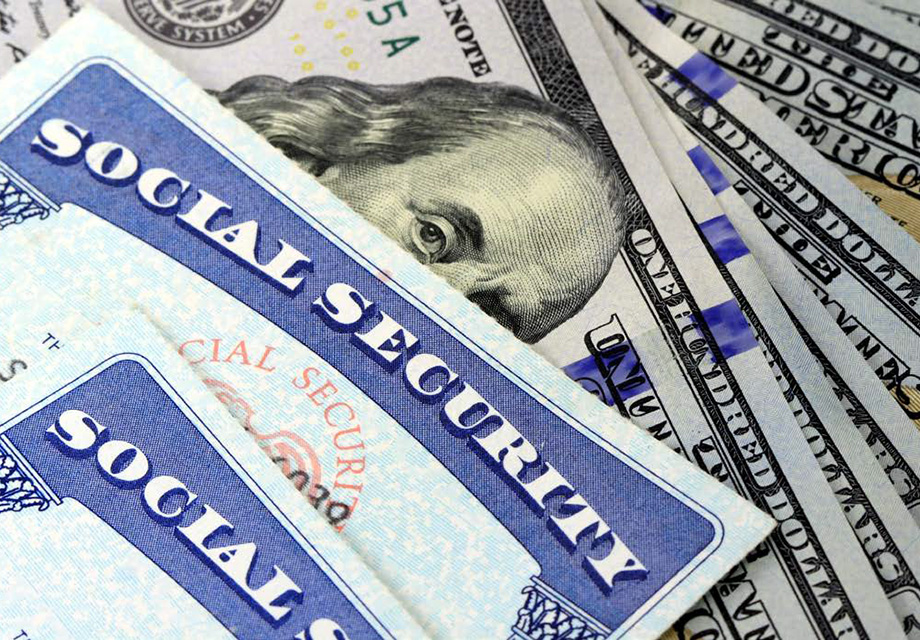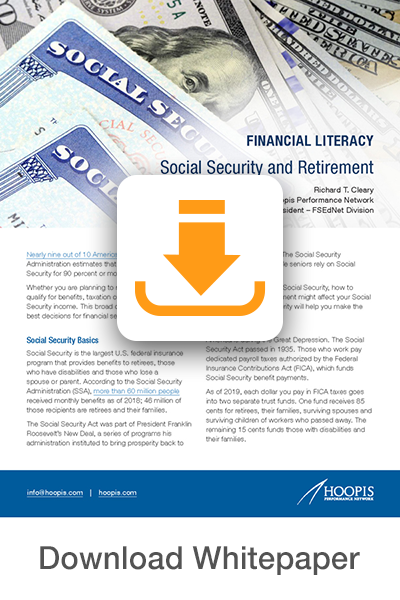Social Security and Retirement

Nearly nine out of 10 Americans aged 65 or older currently receive Social Security. The Social Security Administration estimates that 21 percent of married couples and 43 percent of single seniors rely on Social Security for 90 percent or more of their income.
Whether you are planning to retire in 20 years or 20 days, it’s crucial to understand Social Security, how to qualify for benefits, taxation of Social Security benefits and how working after retirement might affect your Social Security income. This broad overview of the most important aspects of Social Security will help you make the best decisions for financial security during retirement.
Social Security Basics
Social Security is the largest U.S. federal insurance program that provides benefits to retirees, those who have disabilities and those who lose a spouse or parent. According to the Social Security Administration (SSA), more than 60 million people received monthly benefits as of 2018; 46 million of those recipients are retirees and their families.
The Social Security Act was part of President Franklin Roosevelt’s New Deal, a series of programs his administration instituted to bring prosperity back to Americans during the Great Depression. The Social Security Act passed in 1935. Those who work pay dedicated payroll taxes authorized by the Federal Insurance Contributions Act (FICA), which funds Social Security benefit payments.
As of 2019, each dollar you pay in FICA taxes goes into two separate trust funds. One fund receives 85 cents for retirees, their families, surviving spouses and surviving children of workers who passed away. The remaining 15 cents funds those with disabilities and their families.
Qualifying for Social Security Retirement Benefits
Most people must work 10 years at a job where they pay FICA taxes to receive Social Security retirement benefits. As of 2019, the SSA awards one credit for each $1,360 in earnings, with a maximum of four credits per year. The required earnings normally increase each year. The 10-year, 40-credit rule applies to all workers who were born after 1929; those born before 1929 did not need as many credits.
Workers cannot earn credits at all jobs. The following are some examples of jobs where workers do not qualify for Social Security retirement benefits:
- The majority of federal employees hired prior to 1984
- Railroad employees who have more than 10 years of service
- Some employees of state and local governments who have chosen not to participate in the Social Security programs
Social Security Retirement Benefit Amounts
The amount you receive for Social Security retirement benefits depends on your age and the amount of your lifetime earnings. As you earn more, your benefit amount increases. You can begin to receive your retirement income anytime from age 62 to age 70.
The retirement benefit program is designed to pay out the same amount of lifetime benefits, no matter when you choose to file your claim. Of course, how long you live is the factor that has the most impact on total lifetime benefits. The SSA will reduce your retirement payment if you take it early. The longer you wait to collect benefits, the greater the monthly benefit amount will be.
The principle behind this is really quite simple. If you start to receive your monthly retirement benefits early, you will receive more payments over your lifetime. If you begin taking them later, you will receive fewer payments, but the payments will be larger. There are many factors to consider when making this decision. But before you can even think about this, you need to know if, how and when you can receive benefits. So, let’s talk about the full retirement age.
The full retirement age (FRA) is the age you must attain to be entitled to your full, unreduced Social Security retirement benefit. The FRA for those born between 1943 and 1954 is exactly age 66. For those born between 1954 and 1959, their FRA will increase by two months each year. For example, the FRA for those born in 1955 will be 66 years and 2 months. The FRA for those born in 1956 is 66 and 4 months, and so on. The FRA for those born in 1960 or later is exactly 67.
So, to receive an unreduced retirement benefit, which is referred to in Social Security jargon as the “Primary Insurance Amount” (PIA), you must wait until you reach your full retirement age.
If a retiring worker with an FRA of 66 and a PIA of $1,000 chose to receive his retirement benefit at age 62, his benefit would be reduced by 25 percent, or $750 (75 percent of his $1,000 Primary Insurance Amount). If they wait until he reaches his FRA, he will receive his full PIA benefit of $1,000.
The terms the Social Security Administration uses to describe your benefit can be confusing. For example, the word “full” in the term “full retirement age” does not mean the maximum benefit. The maximum benefit occurs at age 70, which is always later than full retirement age, regardless of when you were born.
Now let’s talk about what happens if you wait beyond full retirement age to claim your benefits.
For each year you wait beyond full retirement age to receive your benefit, you receive what’s called a “delayed retirement credit.” This is set in law, so it does not fluctuate with interest rates or the equity markets. It’s 8 percent simple interest per year, based on your primary insurance amount for each year beyond your full retirement age.
Another way to look at this is that your benefit will be 76 percent higher at age 70, compared with age 62, regardless of the PIA. That is, you will receive a monthly retirement benefit from Social Security that is 76 percent higher every month for the rest of your life if you wait until age 70 to receive it. This happens automatically. All you have to do to get your maximum benefit is wait until you reach age 70. No forms, no calls — just wait.
If you want a better idea of what your benefits might be at different ages, visit the SSA website and look up your Social Security statement, or use some of their calculators.
Income Taxes and Social Security
Some people who collect Social Security retirement benefits must pay income tax on a portion of their benefits. The government will tax a portion of their benefits if their total combined income (combined income = total amount of income, including any taxexempt interest, plus half of one’s Social Security benefits) exceeds Social Security’s set base amount. Keep in mind that your “total income” includes more than just your work income.
The SSA will tax 50 percent of your Social Security benefits if either of the following statements is true:
- Your combined income amount is between $25,000 and $34,000 and you are single.
- Your combined income amount is between $32,000 and $44,000 and you are married.
The SSA will tax 85 percent of your Social Security benefits if either of the following statements is true:
- Your combined income is greater than $34,000 and you are single.
- Your combined income is greater than $44,000 and you are married.
Working After Retirement
To maintain a comfortable lifestyle into retirement, Social Security retirement benefits plus savings and other investments are often not enough. This means that many individuals must keep working for a while, even after claiming an early Social Security retirement benefit. Others keep working just remain active and engaged.
At your full retirement age, there is no limit on the amount of money you can earn and still receive your full Social Security retirement benefit. However, if you decide to begin to receive your benefit early and continue to work, be sure to understand how this extra income might impact your Social Security benefits. Social Security will reduce $1 of benefit for every $2 you earn over a set limit. In 2019, this limit on earned income is $17,640 ($1,470 per month), and this limit will go up each year. This continues until you reach full retirement age.
Reduced, but Maybe Not Lost Forever
The amount of reduced benefits lost due to income earnings that exceed the limits are not necessarily lost forever.
Once you reach your full retirement age, Social Security will automatically recalculate a new retirement benefit amount, taking into account any of the lost benefits due to the earned income rule. This calculation will eventually pay out the lost benefit amount, a little bit each year. It normally takes up to 15 years to fully recoup the lost benefit.



